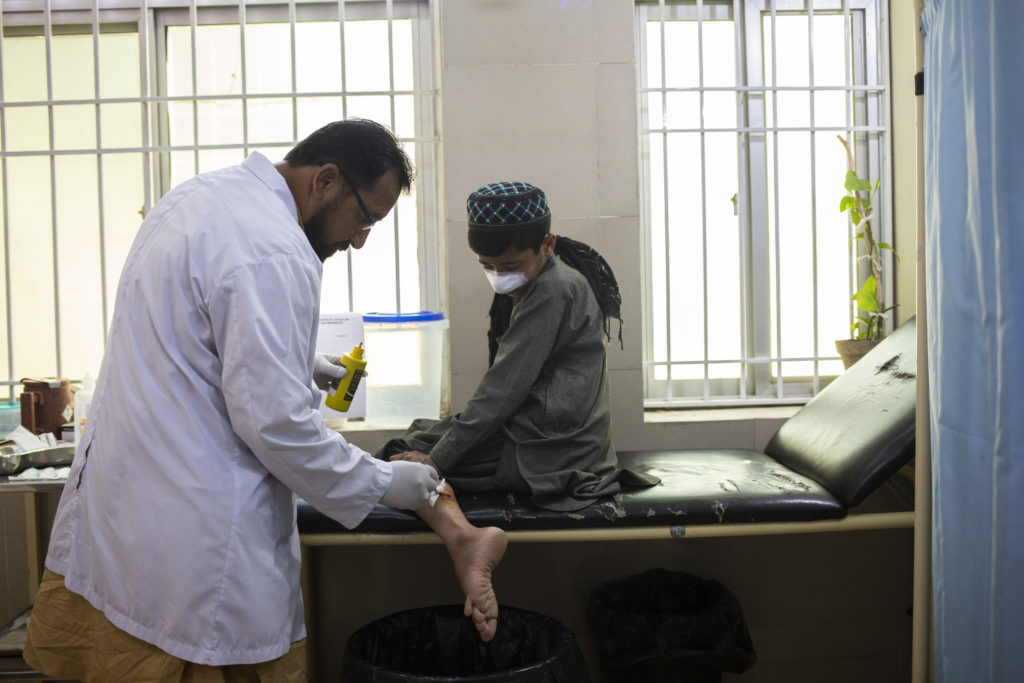In Pakistan, the neglected tropical disease cutaneous leishmaniasis is considered a public health burden. The disease affects people’s skin and causes lesions or ulcers on the body. It is the most endemic in Balochistan and Khyber Pakhtunkwa provinces, but Sindh and central and southern areas of Punjab are also affected.
Cutaneous leishmaniasis is the most common form of leishmaniasis affecting humans. It is also known as ‘saal dana’ or ‘kaal dana’ in Urdu and Pashto languages. It is a single-celled parasite transmitted by the bite of a female phlebotomine sandfly. Although it is not life-threatening, it can cause severe physical disfigurement leading to stigma and discrimination.
Offering medical care
In collaboration with health authorities in Khyber Pakhtunkhwa and Balochistan, Médecins Sans Frontières (MSF) is providing medical care for cutaneous leishmaniasis, including mental health support, to people who need it most.
In Balochistan, MSF is the biggest diagnosis and treatment provider for the disease at three locations in the city of Quetta. Meanwhile, in Khyber Pakhtunkhwa MSF is delivering medical services for the diagnosis and treatment of cutaneous leishmaniasis in Naseerullah Khan Baber Memorial hospital in Peshawar. In October 2021, in order to expand medical care for people in the region, MSF opened satellite clinics in Badaber Rural Health Centre and Telaband basic health unit.
Patients are first diagnosed at Naseerullah Khan Baber Memorial hospital, Peshawar and continue their treatment at the closest satellite clinic, saving the patients’ time and travel costs. Combined, the satellite clinics treat on average 30 patients per month.
Lack of professionals, drug availability mean difficulty accessing treatment
Cutaneous leishmaniasis is a curable disease. A medication called meglumine antimoniate is injected either into the lesions directly or a muscle daily for 20 to 28 days or on a bi-weekly basis for 4 to 6 weeks, depending on the severity of the infection.
However, this treatment is not widely available in public healthcare facilities in the country as it is not manufactured in Pakistan. If available in private clinics, it is often expensive. Now in Pakistan there are only two providers of this necessary medication: MSF and the World Health Organisation. If the medication was more widely available, more people would be able to access quality medical care and their cutaneous leishmaniasis would more likely be cured.
However, even when the treatment is available, medical professionals lack the knowledge and skills to treat the cutaneous leishmaniasis patients in a safe and effective manner. . Wrongly or insufficiently treated, it costs people money, time and takes an emotional toll. Besides the treatment, MSF teams also provideestraining on the management of cutaneous leishmaniasis in Balochistan and Khyber Pakhtunkhwa for the healthcare providers of the Department of Health.
In 2022, MSF started a clinical trial to investigate alternative treatment modalities for cutaneous leishmaniasis in Pakistan. The new methods will be compared with the current first line drugs used. The first line drugs, meglumine antimoniate and sodium stibio glucaonate, are since decades the only proven effective treatment for cutaneous leishmaniasis in Pakistan. Currently, 71 patients are enrolled in the clinical trial.
Disease affects people’s health and lives
Cutaneous leishmaniasis often affects people, who have very limited resources, poor living conditions or where the disease is highly endemic. Although the disease is not life-threatening, it can have an overwhelming effect on patients. The disease causes a lesion on a visible area on the body, such as the face, hands and feet, which often causes physical disfigurement, life-long scars and severe stigma.
For this reason, cutaneous leishmaniasis patients often experience psychological suffering from being discriminated against by relatives, friends and schoolmates, and be excluded from the community. Faced with visible skin lesions, many people stop going outside, going to school or attending events they used to go to before they contracted the disease.

Treatment includes mental health support
In 2022, MSF treated 3,481 patients in Balochistan and 1,645 patients in Khyber Pakhtunkhwa for cutaneous leishmaniasis. The centres provide diagnosis, specialised treatment, safe and effective medication, and health education about the disease, its treatment and prevention. MSF also provides mental health support to cutaneous leishmaniasis patients at its medical centres in Balochistan. Last year, MSF mental health teams provided 1,150 patients with counselling in Quetta.











